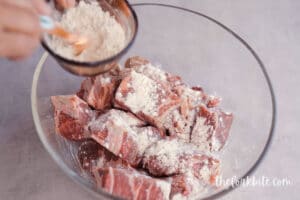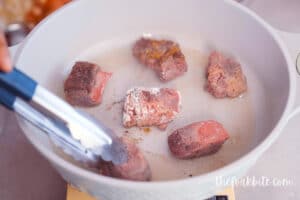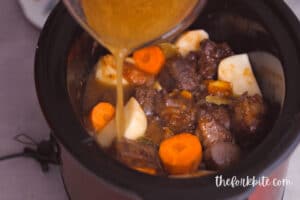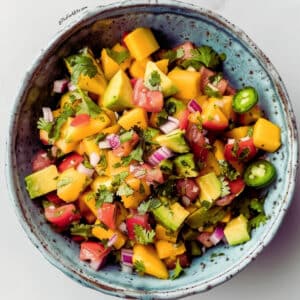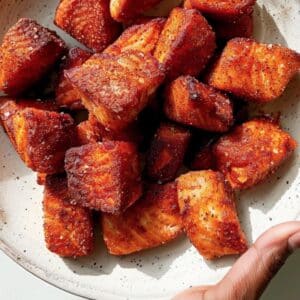Looking for an easy way to make delicious Beef Caldereta? Try using a slow cooker! This Beef Caldereta slow cooker recipe will help you create a mouthwatering dish perfect for any occasion. Tender beef, flavorful tomato sauce, and hearty potatoes are just a few of the ingredients that make this recipe so irresistible. So why wait? Try this Beef Caldereta slow cooker recipe and impress your family and friends with your culinary skills!
Take Aways
- Brown the meat before slow cooking: Sear the meat in a pan before adding it to the slow cooker. This helps to caramelize the surface of the meat, resulting in a more complex and rich flavor.
- Use the right amount of liquid: Beef Caldereta requires a sufficient amount of liquid to keep the meat and vegetables tender and juicy. However, adding too much liquid can dilute the flavors of the dish.
- Let the dish rest before serving: Allow the Beef Caldereta to rest for at least 10 minutes before serving. This helps the flavors to develop and allows the meat to become more tender
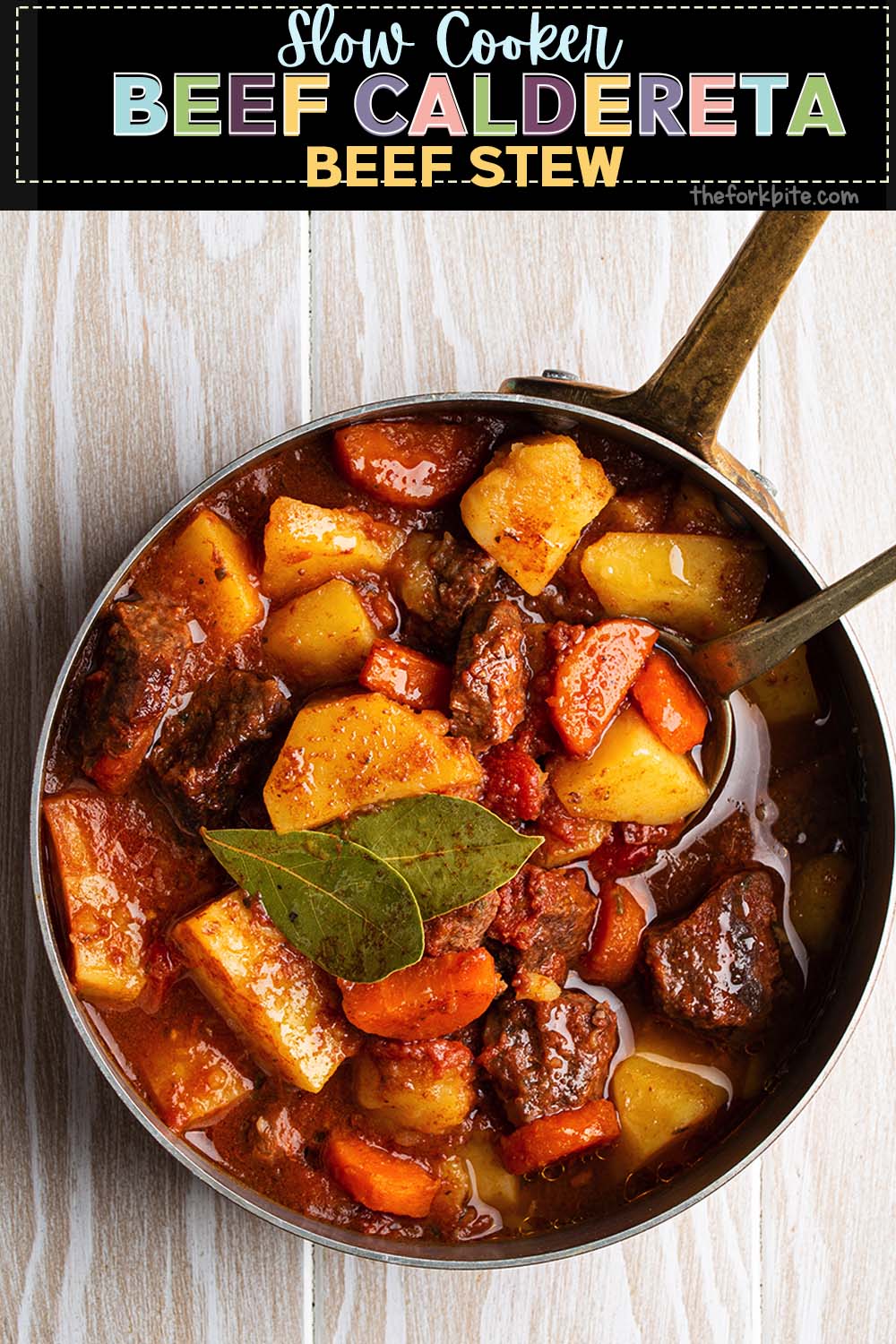
I remember how my grandma used to fire up her wood-fired clay stove about two hours before lunch every summer. The heat outside seemed irrelevant because of the cool kitchen under her bamboo house in the province.
One of the most delicious dishes she cooks is beef caldereta or Asian beef stew. I love the smell of the burning wood and heated clay combined with the delightful combination of veggies, beef chunks, tomato, and coconut milk (or evaporated milk).
She would serve it with some steamed Jasmine rice or native "sinandomeng" rice. Although it is nice to cook beef caldereta the native way, it is faster to have a beef caldereta slow cooker.
Watch the video: Slow Cooker Beef Caldereta
Beef caldereta is comfort food in its very essence. Melty beef dissolves in your mouth, especially if you use the shank or shoulder parts.
Using your slow cooker also manages to blend all those flavors evenly overnight or while you are at work.
I asked my grandmother what her secret ingredient is in making such delicious caldereta. She looked at me and whispered in my ear, "liver pâté."
This made me want to know what she meant by "pâté." So, I wandered into her kitchen while she took a break with her "pamaypay" at the bottom of the wooden stairs.
I found a small can of opened liver pâté. With my index finger, I took a sample and tasted it. My mouth watered. No wonder it was the secret ingredient. My grandmother laughed and called me to her side as the stew simmered.
You can choose the different types of meat or pâté that you want. It is a strange ingredient. Even so, the liver elevates the dish. It also thickens the gravy.
Every mouthful is decadent and savory. The spice needs to be just right so you can appreciate the different flavors you incorporated in it.
Read: Common Mistakes to Avoid When Cooking Beef Stew
How to make beef caldereta in the slow cooker
Grandma pointed out to me the importance of sealing in the flavors of the meat; this is possible through high heat.
The result is a toasty outer layer. This caramelization imparts flavor to the stew as it simmers with the vegetables.
The longer they simmer, the more intense the flavors get. This recipe is also a great way to take all the leftover raw vegetables in your chiller.
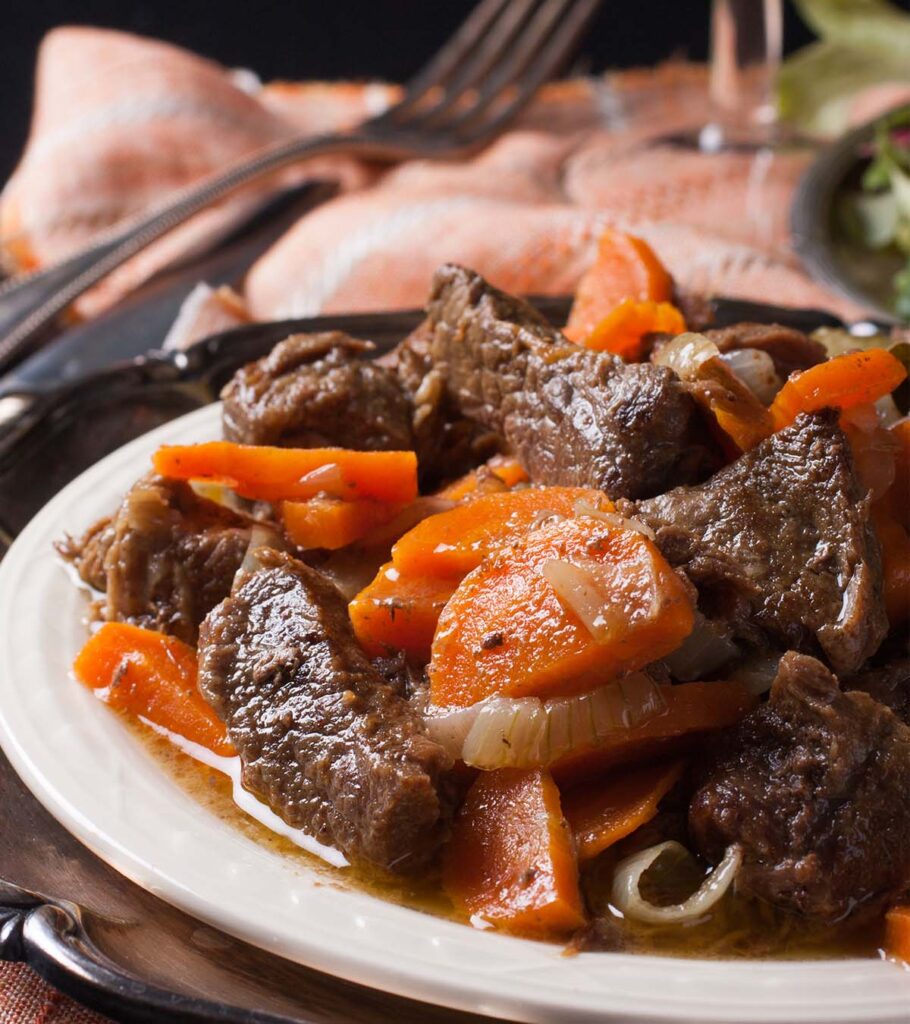
Ingredients you'll need:
- 2.2 lbs / 1-kilo Beef stew meat (chuck roast cut into chunks)
Breading:
- ½ teaspoon garlic powder
- 3 tablespoon flour
- ½ teaspoon salt
- ½ teaspoon black pepper
Other ingredients:
- 3 tablespoons oil
- 3 garlic cloves, peeled and crushed
- 1 large onion, sliced
- 2 tomatoes, chopped
- 2 medium-sized carrots, sliced into 1-inch thickness
- 4 potatoes, peeled and cut into cubes (roughly the same size as the carrots)
- 3 bay Leaves
- 2-3 cups beef broth or water
- ½ cup red wine [optional]
- 1 tablespoon fish sauce or soy sauce (adjust to taste)
- ½ cup Tomato Sauce
- 1 red & green bell pepper
- ½ cup frozen peas
- 2 teaspoons brown sugar (optional)
- Salt and pepper, to taste
Thicken the soup:
- ⅓-1/2 cup liver spread (or pâté), or to taste (maybe replaced with peanut butter
- evaporated milk or coconut milk (optional)
Step-by-step instructions:
Step 1
In a large mixing bowl, mix the salt, garlic powder, pepper, and flour. Toss the sliced beef and lightly coat them with the breading mixture.
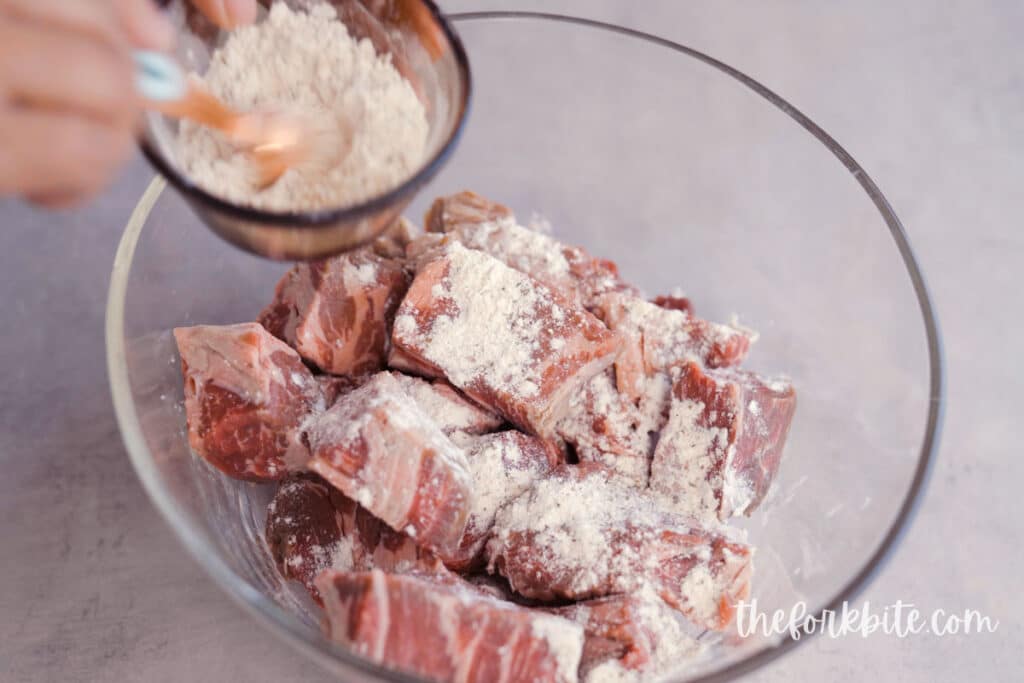
Step 2
Next, get a large frying pan and heat some oil in it. Try not to make it smoking hot.
Step 3
Sear the pieces on all sides until they turned brown. The key is not to crowd the pan. Leaving enough space in between the beef slices will allow them to brown better.
Dumping them all into the pan will result in sticky, light-colored cubes. It is best to brown them in small batches. Make sure to let them rest on the platter. Let each piece absorb all the moisture back.

Step 4
Do not replace the oil. Just add a little more oil if needed, and in the same pan, sauté your tomatoes, garlic, and onions until translucent or until they become fragrant.
Step 5
Pour some beef broth (or red wine) to add more flavor and lift off all the stuck flavors at the bottom of the pan. The wine is optional. It has all the beefy flavors you want in your stew.
Doing this process will de-glaze the pan of the juices from the onion, garlic & tomatoes at the same time, getting all the brown bits remaining for extra flavor.
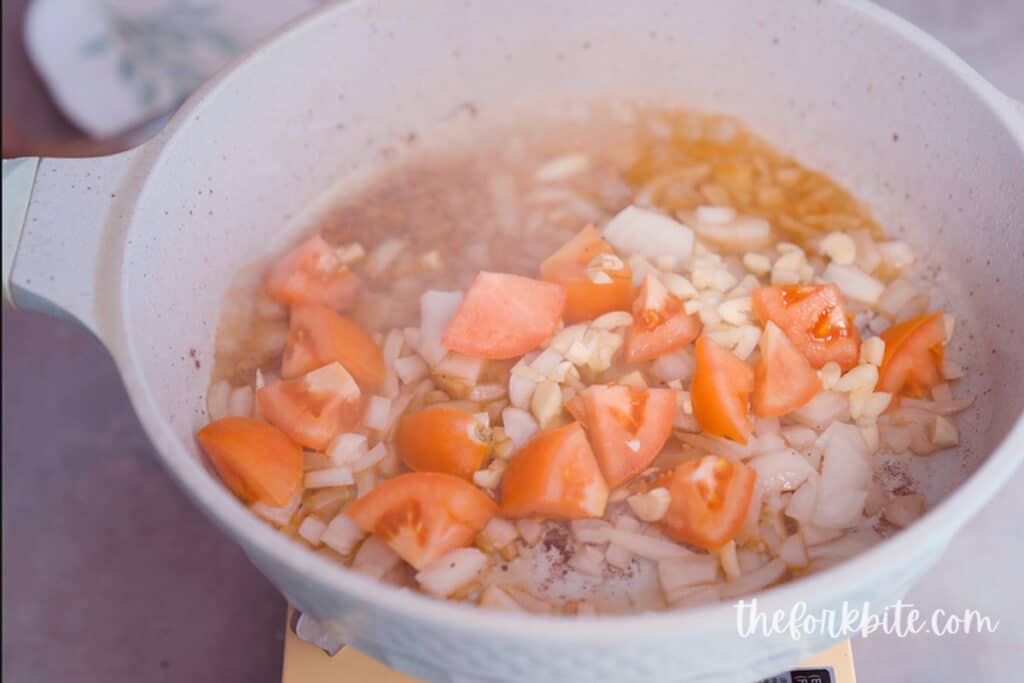
Step 6
Pour the sauteed vegetables into your slow cooker. Add the rested pieces of beef.
Note:
You can skip browning the beef if you're pressed for time or if you have other things to do. But browning the meat is highly recommended.
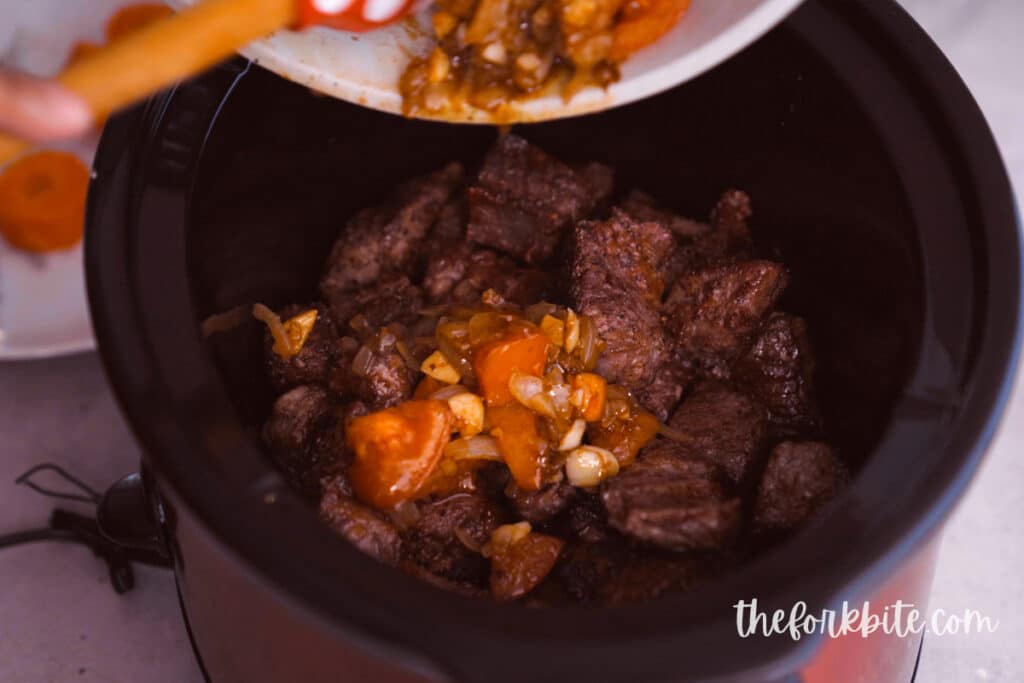
Step 7
Drop the carrots, potatoes, and bay leaves then pour in the beef broth (or you can also use water). Add in the tomato sauce and soy sauce (or fish sauce).
Stir everything and cover the pot and cook on low. Let the stew simmer until the meat is fork-tender; this will take about 7 to 8 hours.

Step 8
When the beef stew is ready, add the liver spread or pâté (or you can use peanut butter). Add in the bell peppers and frozen peas. Adding a little sugar will help balance and even enhance the flavor.
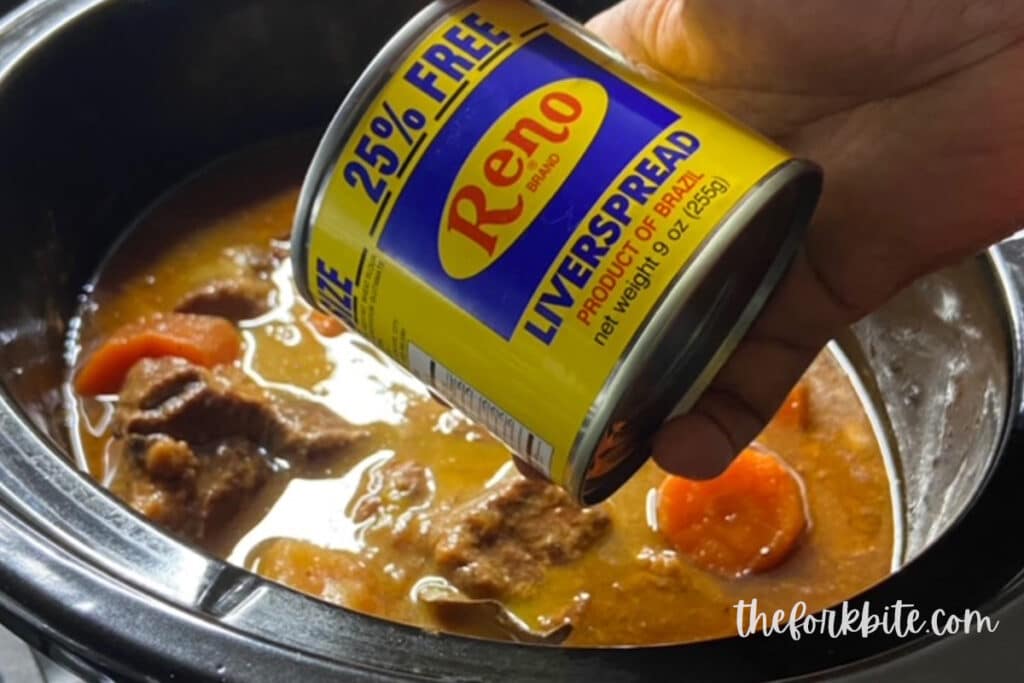
Step 9
Stir gently. Simmer for another half an hour or until thoroughly heated. Serve it with hot, steamed rice.
Some want this stew in a bowl. Season more if you prefer; this will bring out more of the comfort food experience.
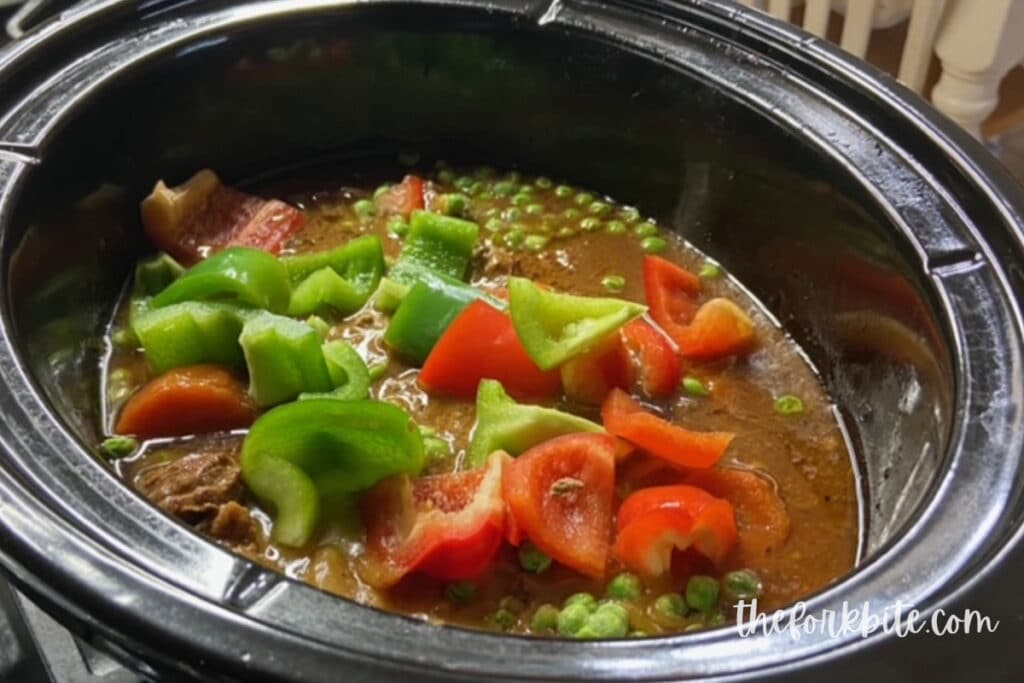
Interesting recipes:
How to brown or sear stew meat
Browning meat in flour adds tenderness and flavor to the meat:
- Cut the pieces of meat into even portions. Slice off the big pieces of fat.
- Place the pieces of meat in a bowl and toss them in seasoned flour. Make sure to coat them evenly.
- Sauté them in a little butter or oil until browned. You can also use bacon grease to bring in extra flavor.
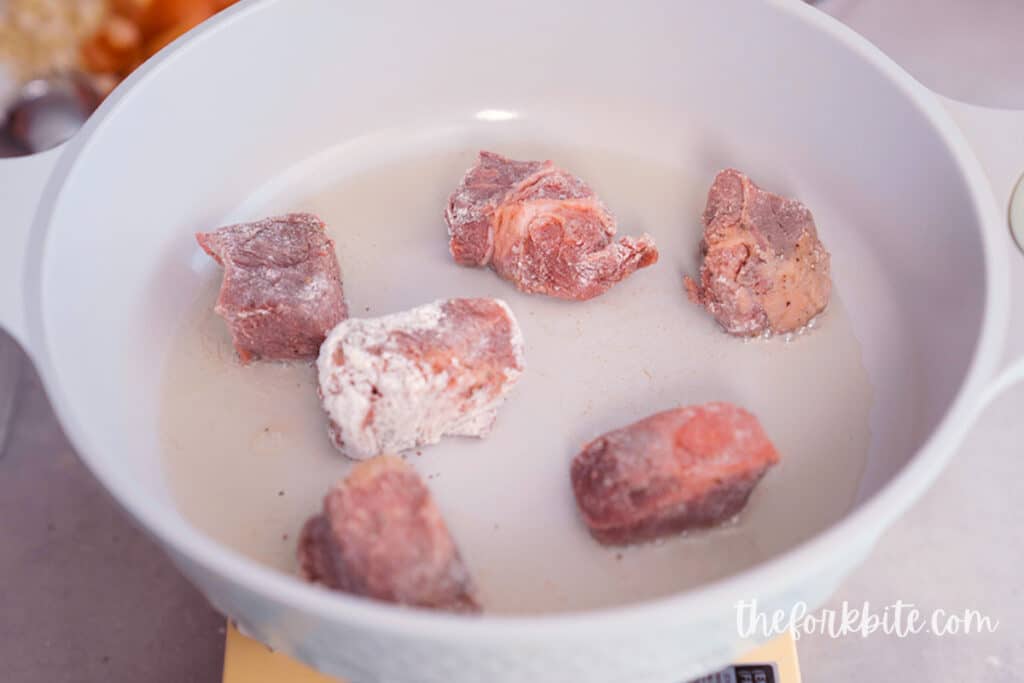
Tips for Browning Stew Meat
- Use oil or butter to coat the pan.
- Brown the beef in small batches to get the best outcome.
- Do not overcrowd the pan. The meat juices will keep the meat from forming a crust.
- Do not stir the beef. Let the sides brown.
- After removing the beef, sauté the vegetables in the pan. Deglazing the pan will lift all the flavors stuck to the bottom of the pan.
Why cook beef stew in a slow cooker?
It's tradition to make a stew the day before serving it. Doing this will allow the flavors a chance to develop. A slower and gentler cooking process will result in a more delicious blend of flavors and more tender meat.
Using a crockpot or slow cooker is a good way to make beef caldereta. It is cost-effective to make it for 6 to 8 hours. This results in tender bites.
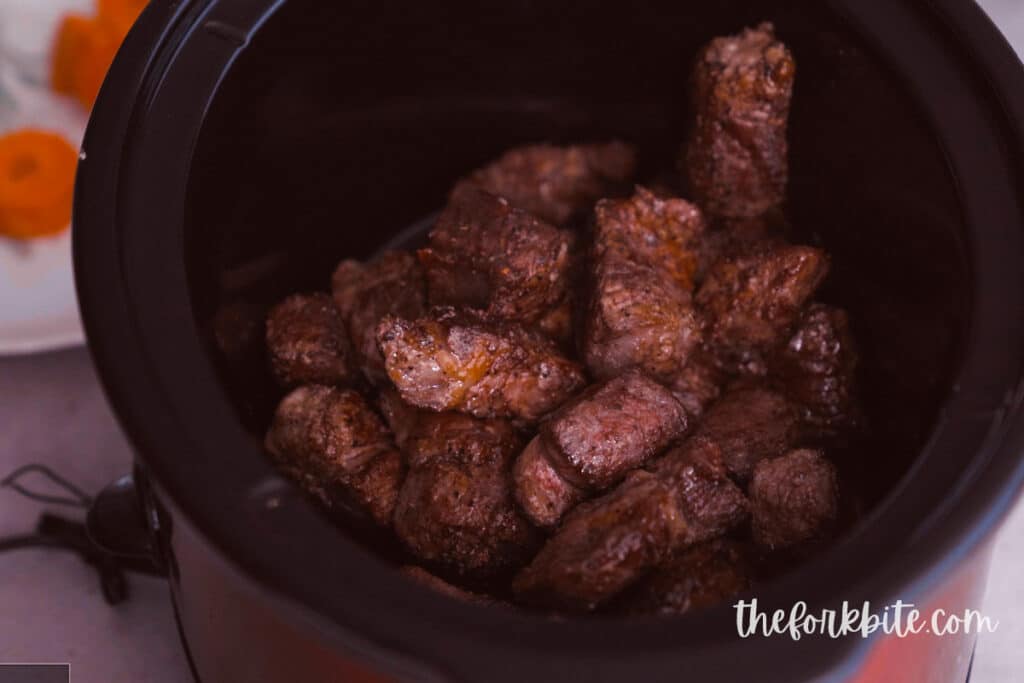
Tips on simmering beef stew
Stews are satisfying and hearty. You can make it in a slow cooker, in the oven, or on a stove. The long-simmering time over low heat will help develop a rich and full flavor.
- Make sure to use cold water to make a slurry. Mixing the flour with hot water will cook the flour. You need an even flour mixture to add to the hot mix.
- Heating the stew liquid to the boiling point will help prevent the uncooked starchy taste.
- Beef is a fatty type of meat. The fat interlaces with the lean meat. Simmering, it will melt and release the fat into the gravy. To remove the fat, refrigerate the stew overnight or for several hours. This will solidify the fat. It will be easier for you to skim off the fat and throw it away. Making a beef caldereta slow cooker is more convenient. You can just refrigerate the stew after cooling it down. Then, refrigerate it and the next day, you can skim off the fat.
- You can also stir dry potato flakes into the mixture instead of a roux or fat and flour mix. You can also puree a portion of the cooked vegetables with some stew gravy and then add it to the stew.
What's the secret to a good beef stew?
Buying cheap cuts of meat!
Cheaper is better when it comes to beef caldereta slow cooker or traditional beef stew. If you try to use a lean cut of beef, the stew will become tough and chewy each time.
I know this seems backward. It is always the less expensive cuts of meat that result in delicious and melty beef stew.
It may seem like beef tenderloin, ribeye, and top sirloins are optimal. They are, but not for this stew recipe. Simmering these cuts of meat will not give the fat you need to make them melty and tender.
You need the fattier, less prime cuts to provide the fat that you need. Prime cuts demand a different recipe to make their great qualities stand out.
What part of beef is best for caldereta or beef stew?
The chuck is the most appropriate type of meat for the beef caldereta slow cooker.
Getting a thick chuck pot roast and then cutting it into chucks provide the most tender stew meat.
Meat for beef stew often comes from the shoulder or chuck. It comes from larger parts of the animals like pigs, cows, deer, or elk.
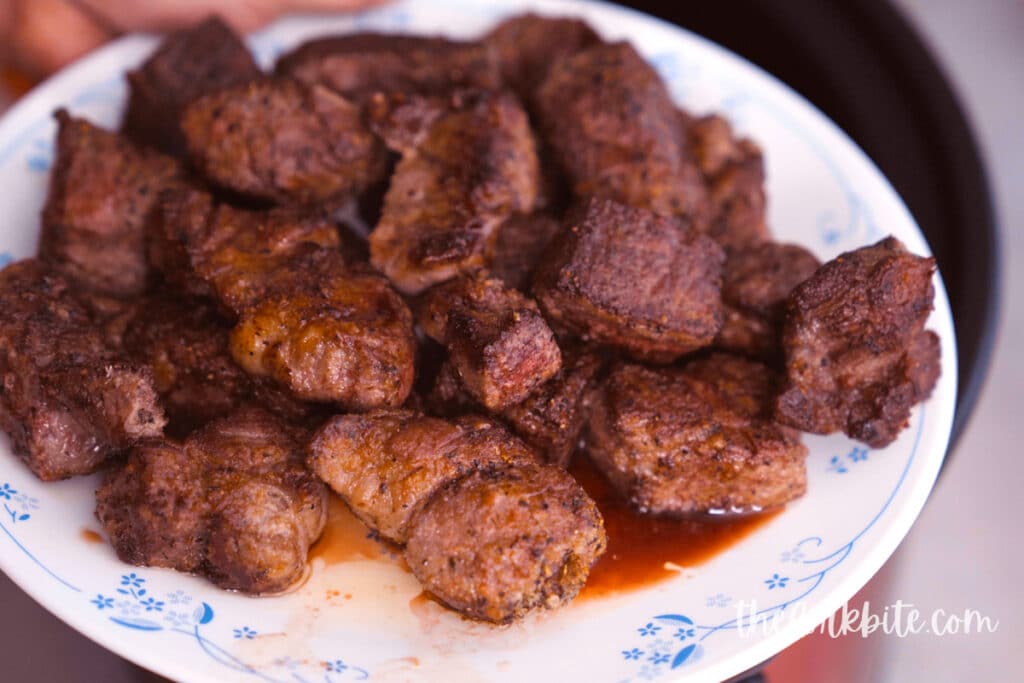
Chuck roast is tougher than rib roast or sirloin. It will become soft and tender if you slow cook or pressure cook it.
These meats make the most delicious beef stew. Slow cooking or pressure cooking breaks down the tough fibers. The beef pieces become tender enough to melt in your mouth.
Steak and round cuts make tender stew.
I recommend chuck because it has more fatty and connective tissue.
Most home cooks prefer it because it has a consistent cooking texture and time. They become juicy and tender each time.
Purchasing beef stew meat from the meat store is often a mixture of bits and pieces from larger cuts of meat. Talking to the butcher can help you get the best stew meat cuts.
Why do tough cuts work best?
Tough cuts of meat result from worked muscles; stronger muscles have excessive collagen in their connective tissue.
Connective tissue is not similar to intermuscular fat. It will not melt into the stew easily. Instead, it melts into the meat and releases gelatin. The meat then gains a rich mouthfeel.
To gain this type of texture, you need to wait for hours while boiling the meat in very low temperatures.
The longer the chuck cooks, the moister the meat cuts become. They are the ideal cuts for beef caldereta slow cooker.
Chuck shoulder and chuck-eye roast will be good substitutes for chuck roast if you cannot get it.
Bone-in parts like oxtail and short ribs can bring more flavor to your stew broth.
An oxtail portion will give you a gelatin-rich broth. Some love this texture, but others do not.
Read: 9 Ways How to Tenderize Tough Meat
How to make the stew meat tender
The most delicious meat for caldereta comes from the tougher cuts. Even so, it does not mean they need to become tough once in the stew.
Cooking these cuts low and slow is the key to a delicious stew. Placing enough liquid in the Instant Pot, crockpot, or casserole dish will help tenderize the meat. This will ensure the best flavor and texture. Tough meat needs more time.
What can I substitute for liver spread?
You don't have to be nervous if the store runs out of liver spread for your caldereta. Liver spread is the traditional ingredient for making local beef stew thick and creamy.
You don't need to add cream or other dairy products to get the thick gravy you want.
You can always replace liver spread with delicious alternatives:
1 Use peanut butter.
This is a thick and creamy sandwich spread. You might not think this ingredient would be delicious in caldereta, but it sure is!
Peanut butter in caldereta will be very creamy from the peanut butter. It can help thicken the sauce while giving it a nutty flavor that you will love.
2 Add quick-melting cheese.
Cheese can make caldereta creamy. Many cooks use this for their version of beef caldereta. Cheese also imparts a salty umami flavor.
It transforms the texture and taste of the dish without even taking over.
3 Use a real liver.
Using real liver will also give you the creaminess you need for your beef caldereta. The cooked liver has an ironic taste. It will melt into the sauce and thicken it.
You can choose between chicken and pork liver. Chicken liver gives a creamier texture than pork or beef liver. Yet, once blended and then incorporated into the beef stew. You can add more if you want it to become creamier.
You can make your own chicken liver pâté and add breadcrumbs to thicken it. Correct seasoning will also make it good for placing on toast.
Steps on how to prepare liver spread or pâté:
- Get a medium bowl and in it, marinate 1 to 2 pieces of chicken liver. Add 2 teaspoons of black pepper and soy sauce for about 10 minutes.
- Pan-fry it in hot oil for about 2-3 minutes until each piece is brown. Add in the marinade and cook for two minutes.
- Place the cooked liver in a food processor or blender. Add a little water until you end up with a paste.
How do you thicken beef caldereta?
Caldereta or beef stew will thicken a bit because of the starches in the flour dredging and potatoes. I recommend making it thicker. But making it even more delicious this way will only make you eat more rice.
Ways to Thicken Your Caldereta
1 Liver spread
This is an important ingredient in your beef stew. Note that not all caldereta recipes use caldereta. You can choose not to add liver spread if you don't like the taste. If you do like it, it will add meatiness and creaminess to the beef stew.
2 Make it cheesy
Cheese is not noticeable in the dish when you melt it into the gravy. Here are some reasons to place it into your stew:
Choose a cheese that melts.
Melty cheese will give salty umami to the flavor of the tomato sauce. It will also change the consistency of the sauce into a creamy and milky gravy. This will be perfect for the rice.
Mozzarella and other cheeses like it will just form globs of soft cheese into the stew. These are cheeses for lasagna and other baked dishes. Quick-melting cheddar cheese or processed will be fine.
Use the cheese as salt.
Cheese is salty. Adding it first and then adjusting the saltiness by adding salt later will ensure the stew will not be very salty. Controlling and balancing the saltiness will make the stew delicious.
3 Cornstarch slurry
You can also use mashed vegetables and add a little cornstarch to them.
Cornstarch is gluten-free, so I prefer to make a slurry sometimes, effective in thickening stews. Cornstarch produces a transparent and glossy sauce.
How to make a slurry:
This is extremely easy to make.
- Use equal parts flour and cold water. Stirring it well will remove the clumps.
- Pour this mixture a little at a time into the boiling stew. It will thicken until you reach the consistency that you want. Constant stirring will prevent lumps.
- The stew should then boil to trigger the starch and cook the flour.
Be sure to stir the slurry as you pour it into the stew. Sometimes, I use low-sodium or no-sodium broth for the slurry instead of water.
How to thicken stew with flour
You can use flour as a traditional thickener. Adding it to the stew or beef caldereta is possible in different ways. You will want to use about 1 ½ teaspoons of flour per cup of liquid added to the stew.
- Dredge your beef.
Adding the flour by dredging the meat when you sear the meat is a good way to thicken the stew.
This will cook off the flour taste and give body to the stew as well. This will also give the meat a golden crust. Just make sure you provide enough flour for dredging.
- Create a roux.
This needs equal parts butter and flour. Over medium heat, melt the butter in the pot. Whisk in the flour and cook it until it smells nutty and looks golden brown. You can then add in the liquid and whisk it to combine.
- Make a beurre manié.
This is kneaded butter in French; It is a mixture of equal flour and soft butter parts. It is like a roux.
Combine equal parts flour and butter in a small bowl until it is like play dough. You will add it after the liquid so it will not clump. Add this into the stew in small parts until the stew thickens enough.
How do you thicken stew in a slow cooker?
It does not matter what thickener you choose for your stew. Your choice will always need high heat to be effective.
You will have less control over the heat if you use a slow cooker. Make sure the stew is not extremely hot before you put it in your thickener.
Here's how to do it:
- Prop the lid. The lid of a slow cooker traps evaporating liquid. This allows the moisture level to remain as it is. Using a chopstick or a wooden spoon to prop the lid a little will allow some of the liquid to evaporate. This will thicken the stew.
- Puree the stew. An immersion blender will do this job. You can also take some of the stew and blend it. Then, you can add this to the rest of the stew. This will thicken the stew without adding any ingredients.
- Use less liquid. A thicker stew will result from adding less liquid from the start. Adding more liquid will be easier if you need to.
How long does beef stew last in the fridge?
I expect leftovers from making a batch of stew; this is a great option for making next-day meals.
This is handy if you plan the meals in your home. Note that you can keep caldereta in the fridge for three to four days. It is the same for soups, chilis, and casseroles.
Stews are good for feeding a crowd in one sitting. You will get leftovers if you cook this stew for two people. When it comes to reheating stew, I always do it in portions.
This allows the rest of the stew to stay intact. Doing this will give you at least three days' worth of meals.
Tips on cooking in a pressure cooker or instant pot
Below are tips on how to make delicious beef caldereta or beef stew in an Instant pot or pressure cooker:
- Use beef ribs, brisket, or oxtail. These are easy to tenderize in a pressure cooker. They will not become rubbery or stringy at all.
- Use the right amount of water. Do not put liquid to the max level to prevent liquid from bursting out of the valve as you release the pressure.
- Do not include vegetables in your pressure cooking. Doing so will only dissolve. Add them in once the beef is tender enough or when the liquid starts reducing.
What goes with beef stew?
Beef caldereta slow cooker or even traditional caldereta as your main dish accompanies a cup or two of hot rice.
Like adobo, beef caldereta is always better the following day after the flavors have all developed. You can also serve this with crusty bread for your meal.
Read: What Goes Well with Beef Stew
Storing your beef stews
Caldereta is a good make-ahead dish. These are the guidelines for keeping your stew ready and fresh for reheating and eating:
- Cover the container tightly when the stew is cool in the container. Refrigerate this for up to three days.
- You can only refrigerate shellfish or fish stew for up to one day.
- If you froze it, thaw it in the fridge. Heat and eat immediately.
- The green bell pepper intensifies. Onion flavor fades with time. Adjusting the seasoning upon reheating will revitalize the flavors again.
- You can reheat the stew in a microwave or on the stovetop.
Can you freeze beef caldereta or beef stew?
All stews freeze well. You can double your recipe for your beef caldereta slow cooker and then freeze the rest for later.
Curries and stews freeze well and become tastier. Flavors mature as they stay in the freezer.
If food has a lot of onion, eat it within one month. Onion can be more pungent if you freeze it longer. It often overpowers the entire dish. Some find the flavor sweaty, which is not good.
Here are some helpful guidelines:
- Store in airtight, heavy plastic containers. Make sure to leave ¼ -inch to ½-inch of space for expansion inside the freezer.
- You can freeze stew for up to three months.
- If you use cornstarch or flour after freezing, the stew will separate. Thickening the stew first before reheating it will keep this from happening.
- Freezing the stew will make the potatoes grainy and soft. Add in new potatoes when you reheat.
How to defrost beef caldereta or stew?
Leave the beef stew in the fridge overnight to thaw. Reheat it in the microwave or oven.
Reheat the stew with caution. In using the microwave, the carrots or potatoes might explode.
You can then reheat it by decanting the stew in an ovenproof dish. This will change the way the stew looks, but it will taste the same.
Reheating Tips for Perfect Stews
You need to think about your thickening agent first before you freeze your beef stew:
Tip 1
If you reduce the liquid to thicken it, you can freeze it in a plastic food container or a freezer bag without issues.
Tip 2
If you used corn flour or flour, the stew would likely separate/ You can use rice flour to make it more stable after you freeze it.
Tip 3
Pour some of the defrosted liquid into a small bowl and then add more cornflour into it. Whisk it well to stabilize it again.
Add this to the stew when it starts to simmer. Stir it gently to avoid breaking up the vegetables.
Note:
Place a plastic wrap over the surface of the stew, then put the lid on. Make sure you leave an air gap between the lid and the food if you use a rigid food container.
This extra effort will stop moisture pockets from forming on the stew's surface. This can lead to freezer burn on the vegetables in your beef caldereta slow cooker.
Full Recipe
How to Make Beef Caldereta or Beef Stew in Slow Cooker
Pin RecipeEquipments:
- Slow Cooker
Ingredients:
- 2.2 lbs Chuck roast or chuck shoulder (cut into chunks)
Breading ingredients:
- 3 tablespoon flour
- ½ teaspoon garlic powder
- ½ teaspoon salt
- ½ teaspoon black pepper
Other Ingredients:
- 3 tablespoon oil
- 1 onion (large)
- 4 cloves garlic (peeled and crushed)
- 2 pieces tomatoes (chopped)
- 2 pieces carrots (sliced in 1-inch thickness)
- 4 pieces potatoes (peeled and quartered sliced)
- 3 pieces bay leaves
- 3 cups beef broth (or water)
- 1 tablespoon fish sauce (or soy sauce – adjust to taste)
- ½ cup tomato paste
- 1 piece red and green bell pepper
- ½ cup frozen peas
- 2 tablespoon brown sugar (this is optional)
- salt and pepper to taste
Thicken the Stew:
- ⅓ cup liver spread (or liver pâté)
- ½ cup evaporated milk (optional)
Watch the Video:
Instructions:
Brown the Beef:
- In a large mixing bowl, mix the salt, garlic powder, pepper, and flour. Toss the sliced beef and lightly coat with the breading mixture.
- Next, get a large frying pan and heat some oil in it. Try not to make it smoking hot.
- Sear the beef pieces on all sides until they turned brown. The key is not to crowd the pan. Leaving enough space in between the beef slices will allow them to brown better.Dumping them all into the pan will result in sticky, light-colored cubes. It is best to brown them in small batches.Make sure to let them rest on the platter. Let each piece absorb all the moisture back.
- Do not replace the oil. Just add a little more oil if needed, and in the same pan, sauté your tomatoes, garlic, and onions until translucent or until they become fragrant.
- Pour some beef broth (or red wine) to add more flavor and lift off all the stuck flavors at the bottom of the pan. The wine is optional. It has all the beefy flavors you want in your stew.Doing this process will de-glaze the pan of the juices from the onion, garlic & tomatoes at the same time, get all the brown bits remaining for extra flavor.
Time to Slow Cook:
- Pour the sauteed vegetables into your slow cooker. Add the rested pieces of beef.Note: You can skip browning the beef if you're press for time or if you have other things to do. But browning the meat is highly recommended.
- Drop the carrots, potatoes, and bay leaves then pour in the beef broth (or you can also use water). Add in the tomato sauce and soy sauce (or fish sauce).Stir everything and cover the pot and cook on low. Let the stew simmer until the meat is fork-tender; this will take about 7 to 8 hours.
- When the beef stew is ready, add the liver spread or pâté (or you can use peanut butter). Add in the bell peppers and frozen peas. Adding a little sugar will help balance and even enhance the flavor.
- Stir gently. Simmer for another half an hour or until thoroughly heated. Serve it with hot, steamed rice. Some want this stew in a bowl. Season more if you prefer; this will bring out more of the comfort food experience.
Notes:
What part of beef is best for Caldereta or beef stew?
The chuck is the most appropriate type of meat for the beef caldereta slow cooker. Getting a thick chuck pot roast and then cutting into chucks provide the most tender stew meat. Meat for beef stew often comes from the shoulder or chuck. It comes from larger parts of the animals like pigs, cows, deer, or elk.Nutrition Information:
Please note that all nutrition information are just estimates. Values will vary among brands, so we encourage you to calculate these on your own for most accurate results.


